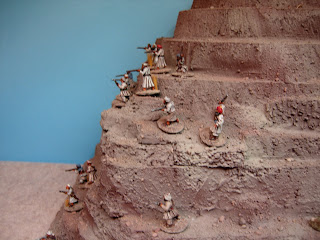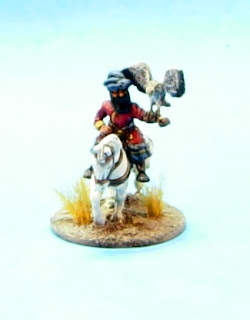
The Pathans

I suppose my Pathan tribesmen aren't really soldiers of the Raj, but it wold be silly to change the title of the series with the 5th installment. Half of them have probably served in the Guides anyway.


I didn't really give the defenders of the Faithful much thought though. I started with about 100 second hand figures; a mix of Old Glory Pathans with rifles and OG Pathan Command and some Foundry Darkest Africa Zanzibaris. I've since added about 20 Bicorne kneeling and prone tribesmen armed with jezzails.

For cavalry I have a bag of 10 Old Glory mounted tribesmen. Another 10 Bicorne mounted tribesmen armed with lances and rifles have made it to the undercoating stage.

For the ghazis, the wild sword waving religious fanatics who gave the British so much worry, I have co-opted about a dozen Old Glory sword armed infantry from my Medieval Saracen army. I also have another dozen or so Bicorne ghazis I haven't painted yet.

 To lead them I got the Essex Khitan Lio warlord with the falcon. But as I was base coating him I realized He's got no beard! No self-respecting Pathan khan is going beardless! Plus he was wearing a fur trimmed cap instead of a turban. Green stuff to the rescue and I added a beard and a turban to him.
To lead them I got the Essex Khitan Lio warlord with the falcon. But as I was base coating him I realized He's got no beard! No self-respecting Pathan khan is going beardless! Plus he was wearing a fur trimmed cap instead of a turban. Green stuff to the rescue and I added a beard and a turban to him.
 To inspire the warriors I have co-opted this Gripping Beast sword-waving, fire-breathing imam from my Medieval Saracen army. He's definitely preaching a jihad.
To inspire the warriors I have co-opted this Gripping Beast sword-waving, fire-breathing imam from my Medieval Saracen army. He's definitely preaching a jihad.The Pathans and British both built sangars in defensive positions. These are roughly semi-circular low walls built of loose rock. I got the idea to make them from "John the OFM" on The Miniatures Page. The base is an obsolete computer CD cut in half. Around the curved edge I lay a bead of Gorrilla Glue (tm) and cover with damp fish tank gravel (bought in the black colour). Gorrilla Glue is interesting stuff. It reacts with water and expands as it sets. The more water the more expansion. Give it 24 hours and then shake off the loose gravel. Repeat to make another layer. Repeat as many times as you want until you get the height desired. I then spread a thin layer of epoxy on the rest of the CD and cover in sand. Some quick painting and drybrushing and there you have it. I use the same technique to make my WW2 shell craters and rubble.

The Pathans didn't generally have artillery but I allow Usman Khan to have two. They're obviously old captured 7 pounder mountain guns (from Bicorne). Crewing them are some Bicorne Mahdist artillery crew. The sponge is ridiculously big, but what can you do? When defending something like a fort they might get to use a Napoleonic era 12 or 24 pounder.

Not to be outdone, the Pathans have their own rear-echelon elements. A flock of sheep and shepherd (from Bicorne):

And a bazaar. The civilians and stalls are all Bicorne. The Bicorne stalls have nice tops full of goods but the bottoms are these awkward boxes that would be a pain to assemble. So I made the wooden stall frame works out of match sticks and used tea-dyed cotton for the awnings and then inserted the Bicorne cast table tops between the legs of the frame work. Somewhere, I think on the Red Shadow wargames website I saw a rug merchant that used printed out and rolled up rugs. I've dutifully printed off the sheet of rug graphics and have some interesting beads to make more pots, but I still have to assemble the stalls.

I like the idea of using markers in my games, but they do take money and effort. I had an extra Bicorne moutain gun with badly cast wheels so I made a wrecked gun marker. Beside it is one of several Bicorne ammo boxes for indicating 'low ammo' status.

I also got a bunch of casualties from Bicorne and added some extra rifles from RAFM. I'm debating either rebasing them on round bases with numbers from 1 to 8 or just adding numbers around the current bases to indicate the number of hits on a unit.

I've got casualty figures for the British and Indian troops too, but I haven't painted them up yet. I probably should move that to the top of the 'to-do' list, then I can stop using the rubber casualty caps for my Colonial games.
New Frontiers
This has perhaps been my most versatile army. Units of course show up in Pulp adventure games set in the subcontinent and sometimes they’ve been used for World War One in Palestine scenarios. In a stranger twist, they once traded in their screw guns for lasguns and joined into a play-by-email Warhammer 40K campaign as an Imperial Guard force. Writing the back ground fluff was a lot of fun. I was reading P.G. Wodehouse’s Jeeves and Wooster stories, so the character of my commanding officer; Brigadier General Pelham Gronville Wooster V.C., with his chief of staff, Major Jeeves and faithful batman Radu became well established. But the campaign fell apart just as I moved to engage some Chaos forces and signaled a “Tally-ho!” to my allies. Probably for the best. I find 40K a very unsatisfying game if one plays anything other than Marines.
Lately another friend has got us all drawn into a Victorian Science Fiction campaign of the Great War of 1885 featuring diabolical steam contraptions and the Prussians invading England. My friend Peter has now sent his Tsarist legions (complete with Cossacks riding clockwork scorpions!) forth to invade Afghanistan with the ultimate goal of seizing the Jewel in the Crown, India. A few steam tanks don’t bother me quite so much as Space Marines and the scratch building challenges of converting something into something else is quite enjoyable. So a 1/35th scale PzII model donated by a friend has had a card board casemate built over top with a gun sticking out the front and a smoke stack on top to make the “Armoured Steam Traction Engine Mk I (India pattern).” An ASTE MkII is in the works using a 1/72nd scale self-propelled gun chassis. It will be smaller and perhaps mount a 1 pounder pompom gun.
Now that I have assembled a varied and balanced force, capable of providing troops for any number of scenarios on the savage North-West Frontier, it only remains to expand my British battalions. These will enable me to expand my campaigning to the Sudan and building up my embryonic Boer forces will enable me to also fight battles in South Africa. Rumor has it that the pirates which infest the mouth of the Kachumbar River have increased their depredations, so a flotilla of gunboats and a small Naval Brigade are in the works as well.
That brings us to the end of the tour through my large and still growing Colonial collection. I really don’t know how I decided to build an Indian Army. I wasn’t even aware that there was a separate “Indian Army” when I started. Maybe it was my fondness for curry; although my appreciation of Indian cuisine has expanded since starting this project. So maybe building the army actually encouraged my appreciation of new culture? Or perhaps it was an infatuation with Bollywood dancing girls? After Gunga Din, Lives of a Bengal Lancer, Kipling and Flashman, I knew I wanted the dusty, rocky hills of the North West Frontier. Whatever the reason, it’s been a lot of fun, many samosas have been consumed and lots of miniatures painted.
Books I Found Useful
http://www.britishempire.co.uk/forces/
Barthorp, Micheal. Indian Infantry Regiments 1860-1914, Osprey Publishing, 1979.
Barthorp, Micheal. Queen Victoria’s Commanders. Osprey Publishing, 2000.
Barthorp, Micheal. The British Army on Campaign (3):1856-1881. Osprey Publishing, 1988.
Barthorp, Micheal. The British Army on Campaign (4):1882-1902. Osprey Publishing, 1988.
Bond, Brian ed. Victorian Military Campaigns. Praeger, New York, 1967.
Churchill, Winston S. Frontiers and Wars. Konecky & Konecky, New York, 1962.
Farwell, Byron. The Gurkhas. W.W.Norton & Co. New York, 1984.
Farwell, Byron. Queen Victoria’s Little Wars. Harper & Row, New York, 1972.
Farwell, Byron. Mr. Kipling’s Army. W.W.Norton & Co., New York, 1981.
Harris, R.G. Bengal Cavalry Regiments 1857-1914. Osprey Publishing, 1979.
Holmes, Richard. Sahib, the British Soldier in India. Harper Collins, 2005.
Hutchinson, Col. H.D. The Campaign in Tirah 1897-1898. The Nafziger Collection, Inc., 2008.
Masters, John. Bugles and a Tiger. Cassell & Co., 2002.
Richards, D.S. The Savage Frontier. Macmillan Ltd., London, 1990.
Wilkinson-Latham, Robert. North-West Frontier 1837-1947. Osprey Publishing, 1977.
To see part 1- cavalry go to this previous posting.
To see part 2- infantry go to this previous posting.
To see part 3- artillery go to this previous posting.
To see part 4-baggage go to this previous posting.
To see this army in action go here.





































































James,
ReplyDeleteI am truly awestruck at your persistence and the quality of your forces. Not to mention the completeness! Very impressive work, sir! I especially like the behind the lines bits you add. Very nice.
www.vbir.blogspot.com
-J
Thanks. This is the result of a few year's effort though! For a couple of years there all I painted were Colonials.
ReplyDeleteNow that I've got enough to run a decent game it's harder to get the motivation to paint up all the rest hiding in boxes.